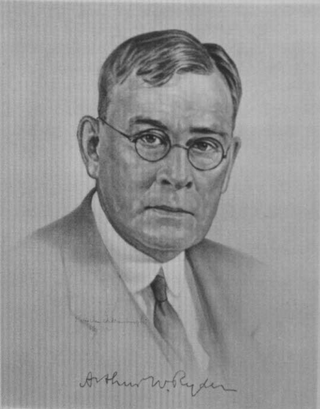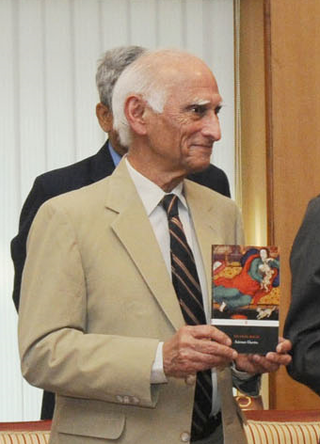
Fable is a literary genre defined as a succinct fictional story, in prose or verse, that features animals, legendary creatures, plants, inanimate objects, or forces of nature that are anthropomorphized, and that illustrates or leads to a particular moral lesson, which may at the end be added explicitly as a concise maxim or saying.

The Panchatantra is an ancient Indian collection of interrelated animal fables in Sanskrit verse and prose, arranged within a frame story. The surviving work is dated to about 200 BCE, but the fables are likely much more ancient. The text's author is unknown, but it has been attributed to Vishnu Sharma in some recensions and Vasubhaga in others, both of which may be fictitious pen names. It is likely a Hindu text, and based on older oral traditions with "animal fables that are as old as we are able to imagine".

Vishnu Sharma was an Indian scholar and author who wrote the Panchatantra, a collection of fables.

Sir Charles Wilkins was an English typographer and Orientalist, and founding member of the Asiatic Society. He is notable as the first translator of the Bhagavad Gita into English. He is also the first person to introduce the term Hinduism which would refer to all the different mythologies and cultures of which were existing in India as one. He supervised Panchanan Karmakar to create one of the first Bengali typefaces. In 1788, Wilkins was elected a member of the Royal Society.

Wisdom literature is a genre of literature common in the ancient Near East. It consists of statements by sages and the wise that offer teachings about divinity and virtue. Although this genre uses techniques of traditional oral storytelling, it was disseminated in written form.

Borzuya was a Persian physician in the late Sasanian era, at the time of Khosrow I. He translated the Indian Panchatantra from Sanskrit into Pahlavi. Both his translation and the original Sanskrit version he worked from are lost. Before their loss, however, his Pahlavi version was translated into Arabic by Ibn al-Muqaffa under the title of Kalila wa-Dimna or The Fables of Bidpai and became the greatest prose of Classical Arabic. The book contains fables in which animals interact in complex ways to convey teachings to princes in policy.

De Nobili School is a private Catholic primary and secondary school located in Dhanbad, Jharkhand, India. The school is named after a Christian mission and Jesuit, Roberto de Nobili, who was the first foreigner to master Sanskrit, incognito, in sixteenth century Madurai. He apparently conducted himself like an orthodox Brahmin and is even said to have declared himself to be a descendant of Brahma.
Ramsay Wood is the author of two sui generis modern novels which aim – via vernacular spiels within complex frame-story narratives – to popularize the pre-literate, oral story-listening drama of multicultural animal fables mimed and declaimed along the ancient Silk Road. His books blend The Jatakas Tales, The Panchatantra and the likely role of Alexander the Great's legacy in "bringing the Aesopian tradition to North India and Central Asia" via Hellenization in Central Asia and India. Wood's Kalila and Dimna – Selected Fables of Bidpai was published by Knopf in 1980 with an Introduction by Nobel laureate Doris Lessing.
Durgasimha was the minister of war and peace of Western Chalukya King Jayasimha II. Durgasimha adapted the well-known set of fables, Panchatantra, from Sanskrit language into the Kannada language in champu style. The Kannada-language version, whose central theme has a strong Jain bent, contains 60 fables, 13 of which are original stories. All the stories have morality as their theme and carry a summary section. The Kannada version is the earliest Indian vernacular version, and the author, being a minister, not surprisingly, chose to write a book on political science (Rajniti). The scholar R. Narasimhachar fixed the date of this work as c. 1025, but the modern Kannada poet and scholar Govinda Pai dated the work to 8 March 1031, based on information in the concluding stanza of the manuscript.

Arthur William Ryder was a professor of Sanskrit at the University of California, Berkeley. He is best known for translating a number of Sanskrit works into English, including the Panchatantra and the Bhagavad Gita.

Kalīla wa-Dimna or Kelileh o Demneh is a collection of fables. The book consists of fifteen chapters containing many fables whose heroes are animals. A remarkable animal character is the lion, who plays the role of the king; he has a servant ox Shetrebah, while the two jackals of the title, Kalila and Dimna, appear both as narrators and as protagonists. Its likely origin is the Sanskrit Panchatantra. The book has been translated into many languages, with surviving illustrations in manuscripts from the 13th century onwards.

The Brahmin and the Mongoose is a folktale from India, and "one of the world's most travelled tales". It describes the rash killing of a loyal animal, and thus warns against hasty action. The story underlies certain legends in the West, such as that of Llywelyn and his dog Gelert in Wales, or that of Saint Guinefort in France. It is classified as Aarne-Thompson type 178A.
Narayan Pandit, or Narayana, was the Brāhmaṇa author of the Sanskrit treatise called Hitopadesha — a work based primarily on the Panchatantra, one of the oldest collection of stories, mainly animal fables, in the world. Narayana's dates are not known, but scholarly consensus places the composition of the Hitopadesha at around 800 to 950 CE. The last lines of the book indicate the name of the author as Narayan Pandit:

Aditya Narayan Dhairyasheel Haksar is a well known translator of Sanskrit classics into English. Born in Gwalior, central India, he is a graduate of The Doon School, Allahabad University and Oxford University. He was a career diplomat, serving as Indian High Commissioner to Kenya and the Seychelles, Minister in the United States, Ambassador to Portugal and Yugoslavia, and he also served as Dean of India's Foreign Service Institute and President of the U.N. Environment Programme's Governing Council.
Alexander Hamilton (1762–1824) was a British linguist who was one of the first Europeans to study the Sanskrit language. He taught the language to most of the earliest European scholars of Indo-European linguistics. He became the first professor of Sanskrit in Europe.
A subhashita is a literary genre of Sanskrit epigrammatic poems and their message is an aphorism, maxim, advice, fact, truth, lesson or riddle. Su in Sanskrit means good; bhashita means spoken; which together literally means well spoken or eloquent saying.

Hercules and the Wagoner or Hercules and the Carter is a fable credited to Aesop. It is associated with the proverb "God helps those who help themselves", variations on which are found in other ancient Greek authors.

Johannes Hertel was a German Indologist.

There are many cultural references to donkeys or asses, in myth, folklore and religion, in language and in literature.














